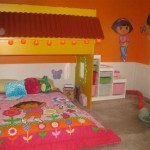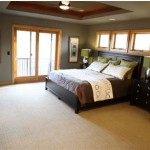Comfortable Bedroom Decorating Ideas
The bedroom serves as a sanctuary, a space for relaxation and rejuvenation. Creating a comfortable and inviting atmosphere is key to ensuring restful sleep and overall well-being. Several design elements contribute to a bedroom's comfort level, encompassing color palettes, textiles, lighting, and furniture arrangement.
Color significantly impacts mood and can either promote relaxation or stimulate the senses. Soft, muted hues like blues, greens, and lavenders are often recommended for bedrooms due to their calming properties. Neutral tones such as beige, gray, and white offer a versatile backdrop and can be easily paired with accent colors in bedding and accessories. Bold or vibrant colors should be used sparingly, perhaps as accents, to avoid overwhelming the space and hindering relaxation.
Textiles play a crucial role in establishing a bedroom's comfort. Soft, high-quality bedding is essential. Natural fibers like cotton, linen, and bamboo are breathable and contribute to a comfortable sleep temperature. Layering bedding with blankets, throws, and quilts adds visual interest and provides warmth during colder months. Area rugs can soften hard flooring and add a touch of luxury. Consider plush, high-pile rugs for a cozy feel underfoot.
Lighting significantly influences the ambiance of a bedroom. Layered lighting is recommended, combining ambient, task, and accent lighting. Ambient lighting provides overall illumination, while task lighting is focused lighting for reading or other activities. Accent lighting highlights specific features or adds a decorative touch. Dimmable lights offer flexibility and allow for adjustment based on the desired mood. Warm-toned lighting is generally preferred for bedrooms as it promotes relaxation.
Furniture arrangement contributes to both the functionality and comfort of a bedroom. The bed is typically the focal point and should be positioned strategically. Consider placing it against a wall with easy access to both sides. Nightstands provide convenient surfaces for lamps, books, and other personal items. A comfortable seating area, such as a chair or chaise lounge, can create a relaxing space for reading or unwinding.
Clutter can negatively impact relaxation and sleep quality. Maintaining a tidy and organized bedroom promotes a sense of calm. Adequate storage solutions are essential for keeping belongings organized and out of sight. Consider utilizing under-bed storage, drawers, and shelves to maximize space and minimize clutter.
Temperature control is crucial for a comfortable sleep environment. Maintaining a cool room temperature is generally recommended for optimal sleep. Consider using blackout curtains or blinds to block out sunlight and regulate room temperature. A fan or air conditioning unit can further contribute to a comfortable sleeping environment.
Personalizing the bedroom with elements that reflect individual preferences can enhance comfort and create a sense of ownership. Incorporating artwork, photographs, or other decorative items that evoke positive emotions can contribute to a calming and inviting atmosphere. Adding plants to the bedroom can also enhance air quality and promote relaxation.
Sound levels significantly impact sleep quality. Minimizing noise distractions in the bedroom is essential for promoting restful sleep. Consider using earplugs, white noise machines, or soundproofing techniques to reduce noise levels. Heavy curtains or blinds can also help to absorb sound from outside sources.
Scent can significantly influence mood and relaxation. Incorporating calming scents into the bedroom can contribute to a more peaceful and restful environment. Lavender, chamomile, and sandalwood are known for their relaxing properties. Essential oil diffusers, scented candles, or linen sprays can be used to introduce calming fragrances into the bedroom.
Creating a comfortable bedroom involves thoughtful consideration of various elements. By focusing on creating a calming and inviting atmosphere through color, textiles, lighting, and furniture arrangement, individuals can transform their bedrooms into true sanctuaries that promote relaxation and restful sleep.
Regularly evaluating and adjusting the bedroom environment can further enhance comfort. Paying attention to personal preferences and making adjustments as needed can ensure a consistently comfortable and relaxing space.
Incorporating elements of nature into the bedroom can also contribute to a calming atmosphere. Natural materials, such as wood and stone, can create a sense of grounding and connection to the outdoors. Natural light is also beneficial for regulating sleep cycles and promoting a sense of well-being.
Minimizing exposure to electronic devices in the bedroom is crucial for promoting restful sleep. The blue light emitted from screens can interfere with melatonin production, making it more difficult to fall asleep and stay asleep. Creating a technology-free zone in the bedroom can contribute to a more relaxing and sleep-conducive environment.

33 Cozy Bedroom Ideas How To Make Your Feel

26 Tips For A Cozier Bedroom
:strip_icc()/cozy-bedroom-ideas-17-c762b3ffbe8d4577a17e99bb71b28ca5.jpeg?strip=all)
23 Cozy Bedroom Ideas How To Design A

101 Bedroom Decorating Ideas 2025 Interior Design

26 Tips For A Cozier Bedroom

Bedroom Style Ideas Cozy Design Tips To Elevate Your Space Saatva

42 Cozy Bedroom Ideas How To Make Your Room Feel

5 Budget Friendly Warm And Cozy Bedroom Ideas The Ponds Farmhouse

33 Ultra Cozy Bedroom Decorating Ideas For Winter Warmth Decor

33 Ultra Cozy Bedroom Decorating Ideas For Winter Warmth







